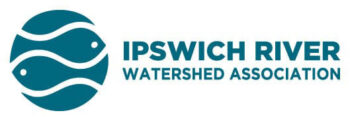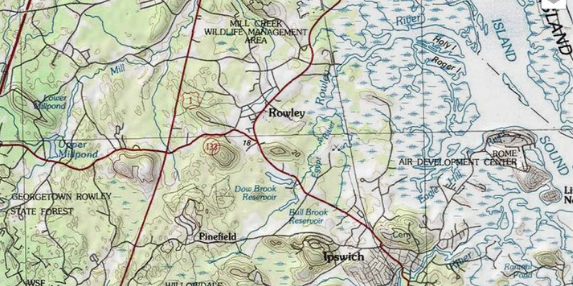Click here to see the full scale, interactive map of the Egypt River, shown in part above.
Traveling to the Egypt
The North Shore’s Egypt River has been a vital natural resource for thousands of years. The river once ran unobstructed into the Great Marsh and Plum Island Sound, providing critical nutrients and sediment to one of the most ecologically important areas on the New England coast. As recently as the 1990’s it was a State-designated Cold Water Fishery with abundant populations. Recorded catches include Brook Trout and sea-run River Herring, Rainbow Smelt and Sea Lamprey. These resources attracted people to the banks of the Egypt River for thousands of years, as indicated by the famous “Bull Brook” archaeological site which is one of the largest and oldest Native American settlements ever documented in the Northeast.
But in less than a generation this incredible resource now routinely runs dry for months at a time and these vital fisheries have been totally eliminated from the River. How did this happen? An expert hydrologist working with the Ipswich River Watershed Association recently concluded that, like the #EndangeredIpswich, the main threat to the Egypt River is not pollution or climate change but water withdrawals. Sadly, there has been a rash of new water withdrawals installed in the river since 1990 for both public and private water supply in addition to farm, playing field and golf course irrigation.
For Executive Director Wayne Castonguay, it’s important to focus on the data. “Our state agency partners, the Department of Environmental Protection(DEP), are responsible for managing water resources, including withdrawals. The Safe Yield is required to be determined by law before assessing requests for new withdrawals. Unfortunately, DEP’s formula for calculating Safe Yield does not take into account smaller river basins such as the Egypt nor the time of year the withdrawal occurs. Although they could calculate the Safe Yield data for all of the smaller 1,400 sub-basins in the state, like the Egypt, they do not use that scale in their withdrawal decision-making.”
Driven by Data
The new hydrologic analysis gives an objective assessment of the data available to the DEP. The analysis uses DEP’s own data to calculate how much water can be safely taken out of the Egypt River. What the data shows is that, in the case of the Egypt River sub-basin, it is already 2 to 3 times over its actual Safe Yield. The numbers help explain why this waterway now runs dry for as much as six months per year.
“We think the state should be looking more closely at safe yield at this scale,” says Castonguay. “This analysis makes it clear, using the state’s own criteria, that this is a highly stressed sub-basin. Going forward we will encourage the state to perform similar analysis on other sub-basins. We will continue to work with our communities to reassess current water uses and guide investments into more resilient water sources.”
“Climate change is making a bad situation worse,” says Patrick Lynch, Director of Policy and Planning. “One thing the climate crisis has revealed is that the state’s current system, which in many cases over-allocates already-limited water resources, isn’t sustainable. Even if we didn’t have two severe droughts in the last five years, we’d still be dealing with how to improve a methodology from a policy-making standpoint, especially in light of climate change. All it’s doing is kicking the can down the road while our communities and natural resource advocates increasingly run into conflicts with each other.”
Thankfully, Ipswich River has long advocated for changes in the Safe Yield methodology and some solutions are on the way. We applaud DEP for recently proposing new regulations that would close one of many loopholes by requiring more water users to conserve water during drought. A Drought Bill the state legislature is set to debate this session would further assist communities in saving water when it matters most.
“Ultimately, we need our state leaders to commit to rethinking this system and revisit how Safe Yield actually plays out in our communities,” says Lynch. “By fixing the methodology and working proactively with local leaders, the state can help us better prepare for climate change. To make sure communities on the North Shore and across Massachusetts can continue to grow, we all need to pool our resources and invest in long-term solutions.”
Those long-term solutions got a boost this summer. The state recently allocated $100,000 to the North Shore Water Supply Resiliency Task Force. The Task Force, established by Senator Tarr, is currently working to increase water resiliency across the region.
Attention is on the region due to the national organization, American Rivers, declaring the Ipswich one of America’s Most Endangered Rivers this year. In April, the Ipswich River Watershed Association launched an #EndangeredIpswich Campaign to leverage the designation. Among the campaign goals are much-needed improvements to state water policy. To learn more about solutions for individuals, municipalities and the state informed by data, visit ipswichriver.org/endangered.

